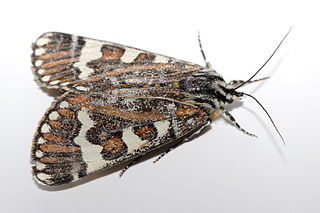
The pasture day moth is a species in the moth family Noctuidae which is active during the day, as its common name implies, making it unlike most other noctuid species. It is found in most southern areas of Australia, ranging from lower Queensland to Tasmania. The species was first described by George French Angas in 1847. It is the only species in the monotypic genus Apina, erected by Francis Walker in 1855.

The Hepialidae are a family of insects in the lepidopteran order. Moths of this family are often referred to as swift moths or ghost moths.

Acronicta is a genus of noctuid moths containing about 150 species distributed mainly in the temperate Holarctic, with some in adjacent subtropical regions. The genus was erected by Carl Linnaeus in his 1758 10th edition of Systema Naturae. Caterpillars of most Acronicta species are unmistakable, with brightly colored hairy spikes, and often feed quite visibly on common foliate trees. The hairy spikes may contain poison, which cause itchy, painful, swollen rash in humans on contact. The larva of the smeared dagger moth is unusually hairy even for this genus. Acronicta species are generally known as dagger moths, as most have one or more black dagger-shaped markings on their forewing uppersides. But some species have a conspicuous dark ring marking instead.

Urodidae, whose species are commonly known as false burnet moths, is a family of moths in the lepidopteran order. It is the type genus in the superfamily, Urodoidea, with three genera, one of which, Wockia, occurs in Europe.

Pseudosphex is a genus of tiger moths in the family Erebidae. The genus was erected by Jacob Hübner in 1818. These moths are mimics of a variety of Hymenoptera. The prefix pseudo means "false", and Sphex is a genus of wasps.
Baecula is a monotypic moth genus of the family Erebidae. Its only species, Baecula gallopavo, is found in Venezuela. Both the genus and the species were first described by Francis Walker in 1859.
Chobata is a monotypic moth genus of the family Noctuidae. Its only species, Chobata discalis, is found in the Dominican Republic. Both the genus and species were first described by Francis Walker in 1858.
Deinopa is a genus of moths of the family Erebidae erected by Francis Walker in 1856. The genus was previously classified in the subfamily Calpinae of the family Noctuidae.
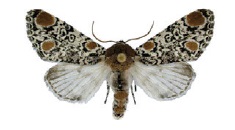
Harrisimemna is a genus of moths of the family Noctuidae. The genus was erected by Augustus Radcliffe Grote in 1873.
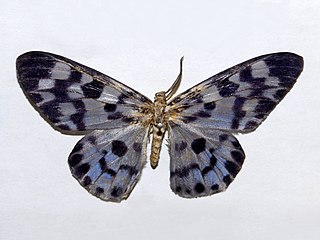
Longicella is a genus of moths of the family Noctuidae. The genus was erected by Karl Jordan in 1896.
Ogoa is a genus of moths in the subfamily Lymantriinae erected by Francis Walker in 1856. The species are known from Africa.
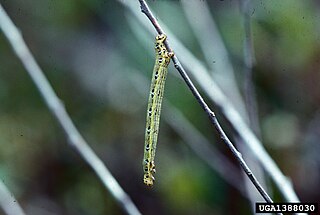
Cingilia is a monotypic moth genus in the family Geometridae erected by Francis Walker in 1862. Its only species, Cingilia catenaria, the chain-dotted geometer, chain dot geometer, chainspotted geometer or chain-spotted geometer, was first described by Dru Drury in 1773. It is found in North America from Nova Scotia south to Maryland and west to Kansas and Alberta.

Acronicta impressa, the impressive dagger moth or willow dagger moth, is a moth of the family Noctuidae. The species was first described by Francis Walker in 1856. It is found from western Canada to north-western Mexico.

Acronicta hamamelis, the witch hazel dagger moth or puzzling dagger moth, is a moth of the family Noctuidae. The species was first described by Achille Guenée in 1852. It is found in Canada and parts of the United States, including Maryland.

Andropolia contacta, the Canadian giant, is a moth in the family Noctuidae. The species was first described by Francis Walker in 1856.
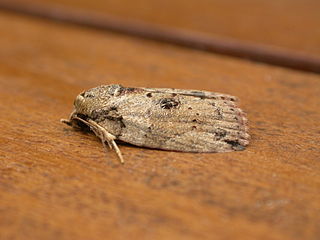
Nanaguna breviuscula, the pigeonpea pod borer, is a moth species of the family Nolidae. It is found from Sri Lanka and India east to Samoa. In Australia it is found in the Kimberleys in Western Australia, the northern part of the Northern Territory and from the Torres Strait Islands and Queensland to Sydney in New South Wales.

Sthenopis pretiosus, the gold-spotted ghost moth, is a species of moth of the family Hepialidae. It was first described by Gottlieb August Wilhelm Herrich-Schäffer in 1856. It can be found in found Brazil, Venezuela and in the eastern United States and south-eastern Canada.
Opharus corticea is a moth of the family Erebidae. It was described by Francis Walker in 1856. It is found in Venezuela.
Phoenicoprocta vacillans is a moth in the subfamily Arctiinae. It was described by Francis Walker in 1856. It is found in Colombia and the Brazilian states of São Paulo and Santa Catarina.
Toosa is a genus of moths of the family Thyrididae erected by Francis Walker in 1856. The species are found in Africa.











